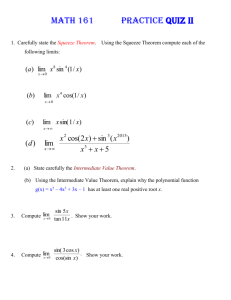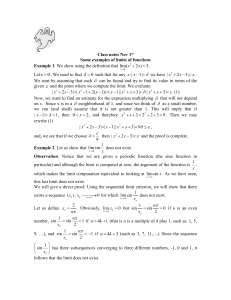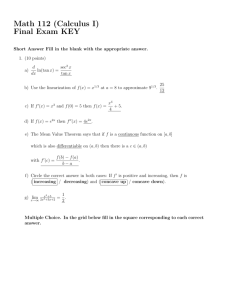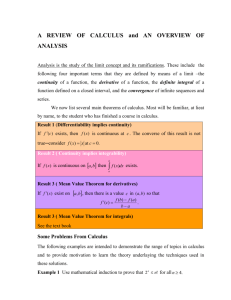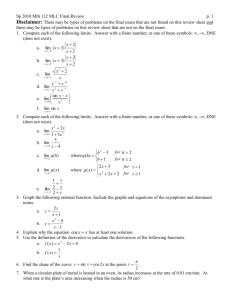Class notes Nov 1st
advertisement
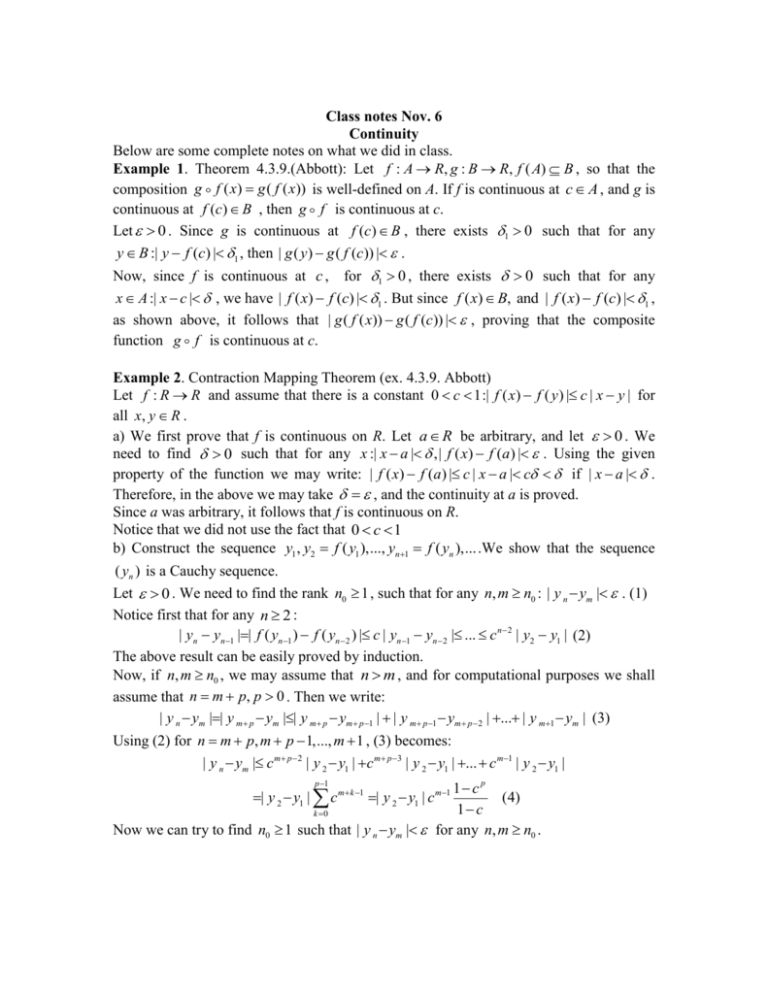
Class notes Nov. 6 Continuity Below are some complete notes on what we did in class. Example 1. Theorem 4.3.9.(Abbott): Let f : A R, g : B R, f ( A) B , so that the composition g f ( x) g ( f ( x)) is well-defined on A. If f is continuous at c A , and g is continuous at f (c) B , then g f is continuous at c. Let 0 . Since g is continuous at f (c) B , there exists 1 0 such that for any y B :| y f (c) | 1 , then | g ( y ) g ( f (c)) | . Now, since f is continuous at c , for 1 0 , there exists 0 such that for any x A :| x c | , we have | f ( x) f (c) | 1 . But since f ( x) B, and | f ( x) f (c) | 1 , as shown above, it follows that | g ( f ( x)) g ( f (c)) | , proving that the composite function g f is continuous at c. Example 2. Contraction Mapping Theorem (ex. 4.3.9. Abbott) Let f : R R and assume that there is a constant 0 c 1:| f ( x) f ( y ) | c | x y | for all x, y R . a) We first prove that f is continuous on R. Let a R be arbitrary, and let 0 . We need to find 0 such that for any x :| x a | ,| f ( x) f (a) | . Using the given property of the function we may write: | f ( x) f (a) | c | x a | c if | x a | . Therefore, in the above we may take , and the continuity at a is proved. Since a was arbitrary, it follows that f is continuous on R. Notice that we did not use the fact that 0 c 1 b) Construct the sequence y1 , y2 f ( y1 ),..., yn1 f ( yn ),... .We show that the sequence ( yn ) is a Cauchy sequence. Let 0 . We need to find the rank n0 1 , such that for any n, m n0 : | y n ym | . (1) Notice first that for any n 2 : | yn yn 1 || f ( yn 1 ) f ( yn 2 ) | c | yn 1 yn 2 | ... c n 2 | y2 y1 | (2) The above result can be easily proved by induction. Now, if n, m n0 , we may assume that n m , and for computational purposes we shall assume that n m p, p 0 . Then we write: | y n ym || y m p ym || y m p ym p 1 | | y m p 1 ym p 2 | ... | y m 1 ym | (3) Using (2) for n m p, m p 1,..., m 1 , (3) becomes: | y n ym | c m p 2 | y 2 y1 | c m p 3 | y 2 y1 | ... c m1 | y 2 y1 | p 1 1 c p (4) 1 c k 0 Now we can try to find n0 1 such that | y n ym | for any n, m n0 . | y 2 y1 | c m k 1 | y 2 y1 | c m1 1 c p 1 | y2 y1 | c n0 1 , so choose n0 1 1 c 1 c (1 c) (1 c) to satisfy: c n0 1 , or (n0 1) ln(c) ln . Since 0 c 1, ln(c) 0 , we | y2 y1 | | y2 y1 | From (4) we have | yn ym || y2 y1 | c m1 (1 c) obtain n0 1 ln / ln(c) (5), and therefore we may choose n0 1 to be the | y2 y1 | smallest positive integer satisfying (5). Then we proved that the sequence ( yn ) is Cauchy. One remark is in place: Notice that in solving for n0 we divided by | y2 y1 | , and one may argue that this quantity may be zero. If it is, then it means that y1 y2 f ( y1 ) , so we found the fixed point of the function f. Since the sequence ( yn ) is Cauchy, it is convergent. Let y lim yn lim f ( yn 1 ) . We n n proved in (a) that the function is continuous, so lim f ( yn 1 ) f ( y ) and we get y f ( y ) . n c) We just proved above that the limit point of the sequence is a fixed point of f, i.e. y f ( y ) . Now we have to show that the fixed point is unique. Suppose there are two such points, x, y : x f ( x), y f ( y ) . Using the contraction property given in the hypothesis we have: | y x || f ( y ) f ( x) | c | y x || y x | since c 1 . But the last inequality is true only if x y , and the uniqueness is proved. d) Since we proved that the fixed point is unique, and the construction in b) always leads to a sequence that converges to a fixed point, it follows that regardless of the initial value y1 , the sequence will converge to the fixed point of the function. Here are some applications of the Contraction Mapping Theorem: Example 3. Consider the function f ( x) sin x . How do we know if f ( x) sin x satisfies the contraction property? Well, it almost satisfies it since for arbitrary x, y R , using the Mean Value Theorem, there exists sin x sin y d x c y such that ( sin)(c) cos c , and therefore we have x y dx | sin x sin y || cos c || x y || x y | But we cannot be certain that the constant is less than one since | cos x | 1 . However, if we apply the iterative process to f ( x) sin x we obtain the fixed point. Let us have a look at the graph first. Since we try to find the value for which sin x x we graph both functions in the same system of coordinates: We see that the solution seems to be x 0 . With a program in Maple (see file) the solution found to an approximation of 0.0001, when y1 2 is x 0.08425963516 . Notice that sin(0.08425963516)=0.08424094766 , so the approximation is within the desired margin of error. Example 4. Let us look at the function f ( x) e x . This function does not satisfy the contraction property on the whole real line, but only for positive real numbers. Indeed, using again the mean value theorem, for any x, y 0 :| e x e y || e c || x y || x y | since ec 1, for c 0 . This however will not hurt since if the start with any value y1 R, e y1 0 so starting with the second iteration all values will be positive. Let us then approximate the solution to e x x . If we start with y1 0 and want a margin of error of 0.0001 we get after 16 iterations the (approximate) solution x=0.5671860501. Check that e0.571860501 0.5671190685 , whereas the solution found with Maple to the equation e x x is 0.5671432904. Below you will see the graphs of the two functions: y e x , y x . Finally, some hints for the homework problems: Exercise 4.2.8: Denote h( x) f ( x) g ( x) . So h( x) 0 for all x A . We want to show that lim f ( x) lim g ( x) , which is equivalent to lim h( x) 0 . Suppose that the opposite x c x c x c happens, that is, lim h( x) L 0 . Show then that there must be a neighborhood of c on x c which h( x) 0, for all x V (c) . Exercise 4.3.7. Use the definition of a closed set that it must contain its accumulation points. If K ' , then it follows that K is closed and you are done. If K ' so there exists a K ' then look at the characterization of an accumulation point and use the continuity of the function. Exercises: sin x 1 . Do not use an argument such as L’Hospital’s Rule. x 0 x 1. Show that lim
